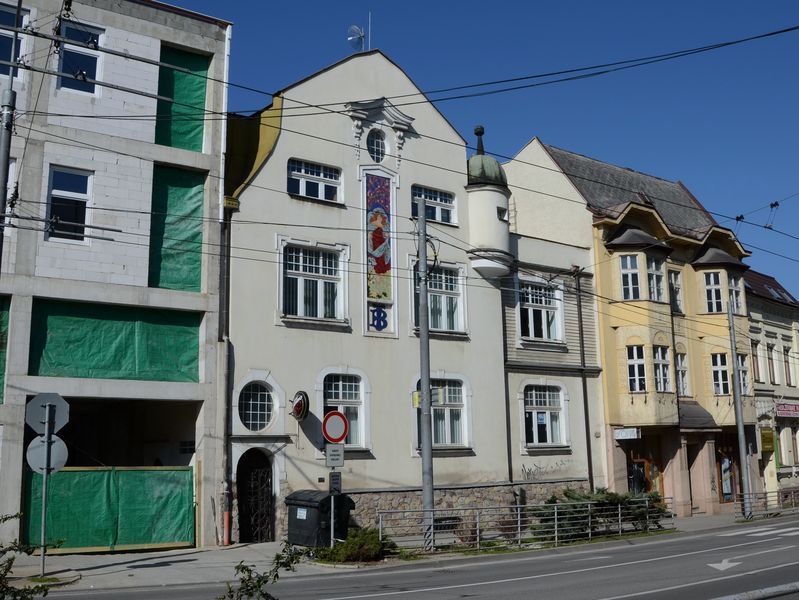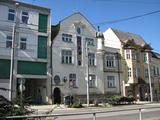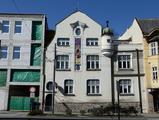Žilina Gallery
» Mesto Žilina » História a archeológia » Pamiatky – QR kódy » Pamiatky QR kódy I » 50 Vykopalov dom
4/8
50 Vykopal's house in Kalov (EN)

50 – Vykopal's house in Kalov
Turistická informačná tabuľka č. 50 s QR kódom na dome Jána Vykopala(Foto: 22. 3. 2014)
Kálov is an old medieval name for the area in Žilina, where a number of single-storey houses were built in the 17th century. Kalov Street was the road to Silesia, along which business among the wool and drapery traders and craftsmen from Žilina had thrived since the 14th century. The road was an old trade route linking the area with Silesia and Poland. Germans came from Tešín in the 13th century and helped found the town. The suburb of Kalov was destroyed by frequent flooding of the River Vah and fire.
The area has a number of important buildings connected with the history of Žilina. What is now Hurbanova Street was originally part of lower Kalov. There are some nice important buildings here, such as the Financial Palace - now Prima Banka Slovakia, Bacher's villa, the Franciscan Monastery, St. Barbara’s Church, Hotel Dubna Skala and Hotel Tatra. Hotel Slovan and Craftsmen’s House are located at the end of the street. From the Middle Ages until 1813, there was a hospital for the poor and sick next to them.
In the early 20th century the original medieval buildings were replaced, mainly by two-storey Art Nouveau buildings, including house no. 3 home to Jan Vykopal a well-known Žilina photographer (9th October 1867 - 27th June 1932 Žilina). Where his house stood, there had been an older house, belonging to Daniel Koren, which Vykopal and his wife Elena, née Kicsin, had bought for 2,400 crowns. Probably in the same year and the subsequent year, an Art Nouveau building was built, which is one of the most beautiful Art Nouveau buildings in Žilina. Originally the building had had no water supply or sewers; at that time the town did not have these conveniences. They were built between 1912 and 1913 and plans dating from that time indicate that a bathroom was added then.
The building is renowned for its unusual facade, dominated by a mosaic of a female figure, reminiscent of the drawings of the Czech painter Alfons Mucha. Tradition has it that the mosaics were the result of an encounter Koren had with Alfons Mucha in Paris, where he was inspired by Mucha’s work. In 1934, following Koren’s death (he died of lung disease), the house was inherited by his children Irena, Albert and Jolana and then later by their descendants. They owned the house until 1961, when it was nationalised.
Ján Vykopal was above all an important photographer especially of the town and its inhabitants. His photographs captured the major social events of the city, various celebrations, marches, exercises, etc. He also photographed residents of the city and surrounding area. Thousands of glass negatives were kept in his photographic archives after his death, but sadly few of them remain today. Some of the negatives relating to Budatín were preserved by museum staff and can still be found there now. Many of the postcards Jan Vykopal produced are currently held in private collections and often appear in auctions. The photographers Maria Vlkova and Vykopal’s daughter Irena were also employed at Ján Vykopal’s photographic studio. His postcards and photographs are a wonderful source for those wishing to explore the town's history, particularly its structural development. His work is part of Žilina’s genius loci.
Žilina photographer Ján Vykopal was apparently a great traveller. At the beginning of the 20th century he travelled much of the world and brought back numerous exotic exhibits, many of which were donated to the Town Museum in Žilina. While on his travels, he visited the Pacific Islands, and the islands of Indonesia, New Caledonia, Fiji, Samoa, Tahiti, Mauritius, Java, New Guinea, Timor and the New Hebrides. In Europe, he also saw Dalmatia, and South American countries, such as Peru and Brazil. He visited the Red Sea region in Aden and even got as far as China to Shanghai. His donations to the museum included dozens of old coins, various kinds of coral, shells, headbands and shell necklaces, hummingbirds, a wooden fan, herbariums of exotic plants, as well as dozens of photos of ports and harbours, ships and boats, sailors, and aborigines, etc. Among the more precious items there were also two artistic wooden daggers in wooden holders, two large bows and arrows, a military axe and a hand-drawn map of the Earth's hemisphere. These items were received by the museum director on 21th February, 1944 and he produced a list of the exhibits. Unfortunately when was museum transferred from the town hall to Budatín castle, the vast majority of the exhibits were lost and no longer featured in the new inventories of museum collections.
Source: Mgr. Jozef Moravčík, Mgr. Peter Štanský. Text prevzatý z webovej stránky TIK Žilina (kliknite): www.tikzilina.eu.
preberanie textov a obrázkov bez zvolenia autora je striktne zakázané
Site Map
Powered by PhpWebGallery
Site Map
Powered by PhpWebGallery


[0] Komentárov